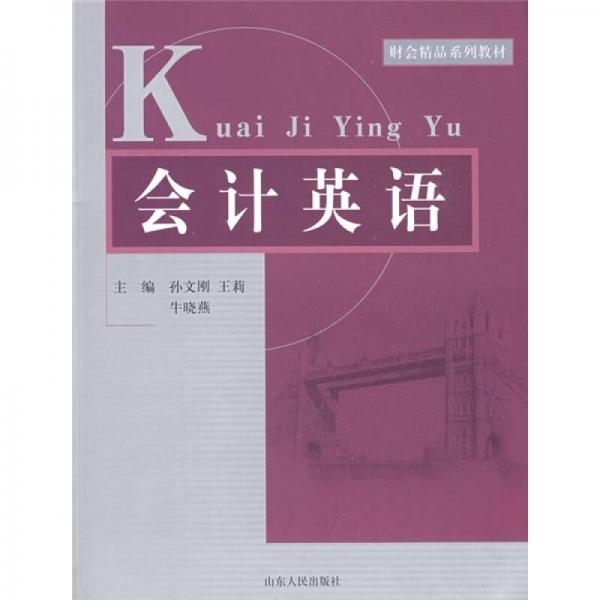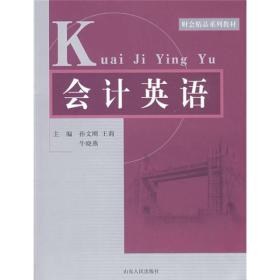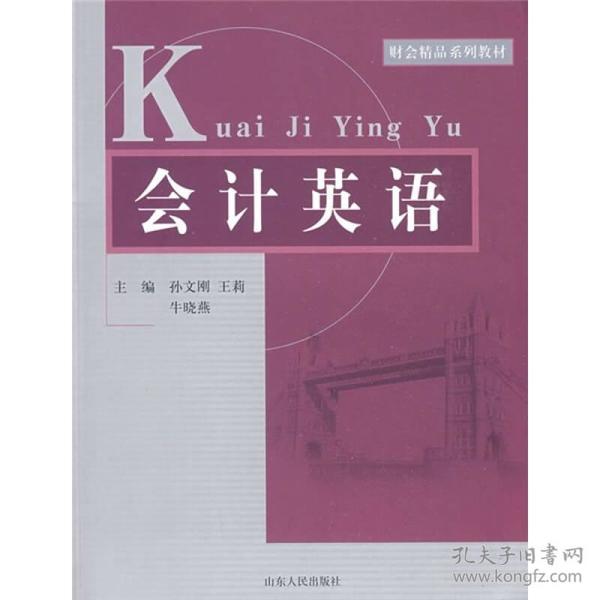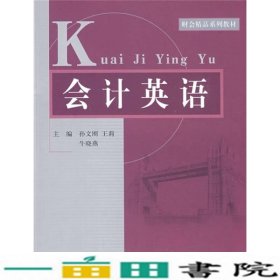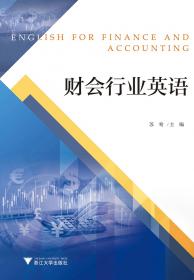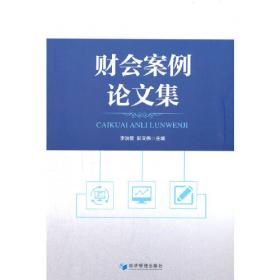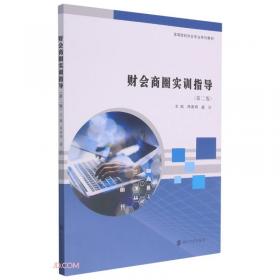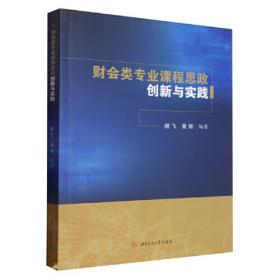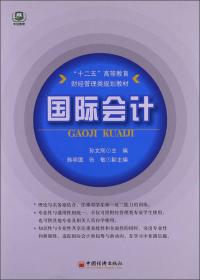财会精品系列教材:会计英语
出版时间:
2009-02
版次:
1
ISBN:
9787209046411
定价:
31.00
装帧:
平装
开本:
16开
纸张:
胶版纸
页数:
329页
字数:
360千字
正文语种:
简体中文
1人买过
-
《会计英语》是一本为财经类专业会计英语教学而编写的专业教材,内容涉及基础会计理论、财务会计、财务管理、审计的主要内容。全书共由五部分组成,第一部分为会计原则和复式记账法,第二部分为主要经济业务的记录,第三部分为报表编制与分析,第四部分为财务基础,第五部分为审计。书中每章后面附有词汇表、练习题或者实务案例,便于广大读者学习使用。作为会计英语教材,《会计英语》尝试用英语讲授会计的专业基础知识。与以往同类的会计英语教材相比,《会计英语》具有以下几点不同:第一,国内同类的会计英语教材往往仅局限于介绍会计业务的详细处理,《会计英语》不仅介绍会计业务的处理,还相应地介绍了财务管理和审计的一些基本知识,便于读者能全面阅读财务报告,了解西方会计专业知识。第二,鉴于会计英语的教学对象主要是高年级学生,对会计专业知识已经有了一定的了解,因而《会计英语》着重介绍会计专业的知识要点,按照“精、新、实”的指导思想来组织编写,以达到培养具有较高的应用技能和基本素质的高等应用型专门人才的目的。第三,由于各国文化、经济、历史背景不同,财务报表的列报以及账户名称的使用千差万别,《会计英语》主要根据国际会计准则和国际财务报告准则中常用的惯例和术语来进行编写。 PARTONE:PRINCIPLESOFACCOUNTINGANDTHEDOUBLE-ENTRYSYSTEM
CHAPTER1PRINCIPLESOFACCOUNTING
1.1TypesofBusinessOrganizations
1.2TheRoleofAccountinginBusiness
1.3IntroductiontoFinancialStatements
1.4TheFrameworkforthePreparationandPresentationofFinancialStatements
1.5TheObjectiveofFinancialStatements
1.6UnderlyingAssumptions
1.7QualitativeCharacteristicsofFinancialStatements
1.8TheElementsofFinancialStatements
1.9RecognitionoftheElementsofFinancialStatements
1.10MeasurementoftheElementsofFinancialStatements
CHAPTERReview
Vocabulary
Questions
CHAPTER2THEACCOUNTINGCYCLE
2.1AccountingCycle
2.2AnalyzeBusinessTransactions
2.3JournalizetheTransactions
2.4PosttoLedgerAccounts
2.5PrepareaTrialBalance
2.6JournalizeandPostAdjustingEntries
2.7PrepareanAdjustedTrialBalance
2.8PrepareFinancialStatements
2.9JournalizeandPostClosingEntries
2.10PrepareaPost-ClosingTrialBalance
CHAPTERReview
Vocabulary
Exercise
PARTTWO:RECORDINGTRANSACTIONSANDEVENTS
CHAPTER3CURRENTASSETS
3.1Cash
3.2TradingSecurities
3.3Receivables
3.4Inventory
CHAPTERReview
Vocabulary
QuestionsandExercises
CHAPTER4NON-CURRENTASSETS
4.1NatureofNon-CurrentAssets
4.2AcquisitionofProperty,PlantandEquipment
4.3DepreciationofProperty,PlantandEquipment
4.4DisposalofFixedAssets
4.5IntangibleAssets
CHAPTERReview
Vocabulary
Exercises
CHAPTER5LIABILITIES
5.1TheCurrentandNon-CurrentLiabilityDistinction
5.2CurrentLiabilities
5.3Non-CurrentLiabilities
5.4ProvisionandContingentLiabilities
CHAPTERReview
Vocabulary
Exercises
CHAFFER6OWNERSEQUITY
6.1AdvantagesandDisadvantagesofaCbrporateEntity
6.2ClassificationofShares
6.3EquityinCompany
6.4AccountingforShareIssues
6.5AccountingforRetainedEarnings
6.6AccountingforDividend
6.7AccountingforOtherReserves
6.8AccountingforIncomeTaxesbyCompanies
CHAPTERReview
Vocabulary
Exercises
PARTTHREE.PREPARINGFINANCIALSTATEMENTSANDINTERPRETATIONS
CHAPTER7PREPARINGFINANCIALSTATEMENTS
7.1RevisedStandardonPresentationofFinancialStatements:aJointProjectoftheFASBandIASB
7.2StatementofComprehensiveIncome
7.3StatementofChangesinEquity
7.4StatementofFinancialPosition
7.5StatementofCashFlows
CHAPTERReview
Vocabulary
QuestionsandExercises
CHAPTER8FINANCIALSTATEMENTSINTERPRETATIONS
8.1StandardizedFinancialStatementforComparisonPurpose
8.2RatioComputationandInterpretations
8.3UsingFinancialStatementInformation
CHAPTERReview
Vocabulary
QuestionsandExercises
PARTFOUR:FUNDAMENTALSOFFINANCE
CHAPTER9OVERVIEWOFFINANCEANDTIMEVALUEOFMONEY
9.1OverviewofFinance
9.2TimeValueofMoney
9.3AnnualPercentageRate(APR)andEffectiveAnnualRate(EAR)
9.4AnnuityandPerpetuity
CHAPTERReview
Vocabulary
QuestionsandExercises
CHAPTER10FINANCIALMANAGEMENTDECISIONSANDAGENCYPROBLEM
10.1FinancialManagementDecisions
10.2RoleofFinancialManager
10.3GoalofFinancialManagement
10.4CorporateGovernance
10.5AgencyProblemandSolvingMechanism
CHAPTERReview
Vocabulary
Questions
CHAPTER11INVESTMENTDECISIONS
11.1MajorInvestmentCriteriaUsedinCapitalBudgeting
11.2ImportantFactorstoConsiderinCapitalBudgeting
11.3ProFormaStatementsandEstimatedCashFlow
CHAPTERReview
Vocabulary
QuestionsandExercises
CHAPTER12FINANCINGDECISIONS
12.1BasicFeaturesofDebtSecurityandEquitySecurity
12.2BondValuationandClassification
12.3StockClassificationandValuation
12.4InflationandInterestRate
CHAPTERReview
Vocabulary
QuestionsandExercises
PARTFIVE:AUDITING
CHAPTER13ANINTRODUCTIONTOAUDITING
13.1DefinitionofAuditing
13.2ClassificationofAuditing
13.3OtherSpecialTypesofAudits
13.4ProfessionalCodeofEthics
CHAPTERReview
Vocabulary
CaseStudy
CHAPTER14THEAUDITPLANNING
14.1AuditEngagementProcess
14.2DutiesandRightsofAuditors
14.3AuditPlanning
14.4MaterialityLevel
14.5Risk-basedApproachtoAuditing
14.6MaterialityandAuditRisks
14.7OverviewofAuditProcess
CHAPTERReview
Vocabulary
CaseStudy
CHAPTER15IMPLEMENTATIONOFAUDITING
15.1NatureofInternalControl
15.2TestofControl
15.3SubstantiveTesting
15.4AuditSampling
CHAPTERReview
Vocabulary
CaseStudy
CHAPTER16AUDITREPORT
16.1AuditReport
16.2UnqualifiedOpinion
16.3QualifiedOpinion
16.4AdverseOpinion
16.5DisclaimerOpinion
CHAPTERReview
Vocabulary
CaseStudy
APPENDIX
Table1FutureValueFactors
Table2FutureValueofAnnuityFactors(OrdinaryAnnuity)
Table3PresentValueFactors
Table4PresentValueofAnnuityFactors(OrdinaryAnnuity)
-
内容简介:
《会计英语》是一本为财经类专业会计英语教学而编写的专业教材,内容涉及基础会计理论、财务会计、财务管理、审计的主要内容。全书共由五部分组成,第一部分为会计原则和复式记账法,第二部分为主要经济业务的记录,第三部分为报表编制与分析,第四部分为财务基础,第五部分为审计。书中每章后面附有词汇表、练习题或者实务案例,便于广大读者学习使用。作为会计英语教材,《会计英语》尝试用英语讲授会计的专业基础知识。与以往同类的会计英语教材相比,《会计英语》具有以下几点不同:第一,国内同类的会计英语教材往往仅局限于介绍会计业务的详细处理,《会计英语》不仅介绍会计业务的处理,还相应地介绍了财务管理和审计的一些基本知识,便于读者能全面阅读财务报告,了解西方会计专业知识。第二,鉴于会计英语的教学对象主要是高年级学生,对会计专业知识已经有了一定的了解,因而《会计英语》着重介绍会计专业的知识要点,按照“精、新、实”的指导思想来组织编写,以达到培养具有较高的应用技能和基本素质的高等应用型专门人才的目的。第三,由于各国文化、经济、历史背景不同,财务报表的列报以及账户名称的使用千差万别,《会计英语》主要根据国际会计准则和国际财务报告准则中常用的惯例和术语来进行编写。
-
目录:
PARTONE:PRINCIPLESOFACCOUNTINGANDTHEDOUBLE-ENTRYSYSTEM
CHAPTER1PRINCIPLESOFACCOUNTING
1.1TypesofBusinessOrganizations
1.2TheRoleofAccountinginBusiness
1.3IntroductiontoFinancialStatements
1.4TheFrameworkforthePreparationandPresentationofFinancialStatements
1.5TheObjectiveofFinancialStatements
1.6UnderlyingAssumptions
1.7QualitativeCharacteristicsofFinancialStatements
1.8TheElementsofFinancialStatements
1.9RecognitionoftheElementsofFinancialStatements
1.10MeasurementoftheElementsofFinancialStatements
CHAPTERReview
Vocabulary
Questions
CHAPTER2THEACCOUNTINGCYCLE
2.1AccountingCycle
2.2AnalyzeBusinessTransactions
2.3JournalizetheTransactions
2.4PosttoLedgerAccounts
2.5PrepareaTrialBalance
2.6JournalizeandPostAdjustingEntries
2.7PrepareanAdjustedTrialBalance
2.8PrepareFinancialStatements
2.9JournalizeandPostClosingEntries
2.10PrepareaPost-ClosingTrialBalance
CHAPTERReview
Vocabulary
Exercise
PARTTWO:RECORDINGTRANSACTIONSANDEVENTS
CHAPTER3CURRENTASSETS
3.1Cash
3.2TradingSecurities
3.3Receivables
3.4Inventory
CHAPTERReview
Vocabulary
QuestionsandExercises
CHAPTER4NON-CURRENTASSETS
4.1NatureofNon-CurrentAssets
4.2AcquisitionofProperty,PlantandEquipment
4.3DepreciationofProperty,PlantandEquipment
4.4DisposalofFixedAssets
4.5IntangibleAssets
CHAPTERReview
Vocabulary
Exercises
CHAPTER5LIABILITIES
5.1TheCurrentandNon-CurrentLiabilityDistinction
5.2CurrentLiabilities
5.3Non-CurrentLiabilities
5.4ProvisionandContingentLiabilities
CHAPTERReview
Vocabulary
Exercises
CHAFFER6OWNERSEQUITY
6.1AdvantagesandDisadvantagesofaCbrporateEntity
6.2ClassificationofShares
6.3EquityinCompany
6.4AccountingforShareIssues
6.5AccountingforRetainedEarnings
6.6AccountingforDividend
6.7AccountingforOtherReserves
6.8AccountingforIncomeTaxesbyCompanies
CHAPTERReview
Vocabulary
Exercises
PARTTHREE.PREPARINGFINANCIALSTATEMENTSANDINTERPRETATIONS
CHAPTER7PREPARINGFINANCIALSTATEMENTS
7.1RevisedStandardonPresentationofFinancialStatements:aJointProjectoftheFASBandIASB
7.2StatementofComprehensiveIncome
7.3StatementofChangesinEquity
7.4StatementofFinancialPosition
7.5StatementofCashFlows
CHAPTERReview
Vocabulary
QuestionsandExercises
CHAPTER8FINANCIALSTATEMENTSINTERPRETATIONS
8.1StandardizedFinancialStatementforComparisonPurpose
8.2RatioComputationandInterpretations
8.3UsingFinancialStatementInformation
CHAPTERReview
Vocabulary
QuestionsandExercises
PARTFOUR:FUNDAMENTALSOFFINANCE
CHAPTER9OVERVIEWOFFINANCEANDTIMEVALUEOFMONEY
9.1OverviewofFinance
9.2TimeValueofMoney
9.3AnnualPercentageRate(APR)andEffectiveAnnualRate(EAR)
9.4AnnuityandPerpetuity
CHAPTERReview
Vocabulary
QuestionsandExercises
CHAPTER10FINANCIALMANAGEMENTDECISIONSANDAGENCYPROBLEM
10.1FinancialManagementDecisions
10.2RoleofFinancialManager
10.3GoalofFinancialManagement
10.4CorporateGovernance
10.5AgencyProblemandSolvingMechanism
CHAPTERReview
Vocabulary
Questions
CHAPTER11INVESTMENTDECISIONS
11.1MajorInvestmentCriteriaUsedinCapitalBudgeting
11.2ImportantFactorstoConsiderinCapitalBudgeting
11.3ProFormaStatementsandEstimatedCashFlow
CHAPTERReview
Vocabulary
QuestionsandExercises
CHAPTER12FINANCINGDECISIONS
12.1BasicFeaturesofDebtSecurityandEquitySecurity
12.2BondValuationandClassification
12.3StockClassificationandValuation
12.4InflationandInterestRate
CHAPTERReview
Vocabulary
QuestionsandExercises
PARTFIVE:AUDITING
CHAPTER13ANINTRODUCTIONTOAUDITING
13.1DefinitionofAuditing
13.2ClassificationofAuditing
13.3OtherSpecialTypesofAudits
13.4ProfessionalCodeofEthics
CHAPTERReview
Vocabulary
CaseStudy
CHAPTER14THEAUDITPLANNING
14.1AuditEngagementProcess
14.2DutiesandRightsofAuditors
14.3AuditPlanning
14.4MaterialityLevel
14.5Risk-basedApproachtoAuditing
14.6MaterialityandAuditRisks
14.7OverviewofAuditProcess
CHAPTERReview
Vocabulary
CaseStudy
CHAPTER15IMPLEMENTATIONOFAUDITING
15.1NatureofInternalControl
15.2TestofControl
15.3SubstantiveTesting
15.4AuditSampling
CHAPTERReview
Vocabulary
CaseStudy
CHAPTER16AUDITREPORT
16.1AuditReport
16.2UnqualifiedOpinion
16.3QualifiedOpinion
16.4AdverseOpinion
16.5DisclaimerOpinion
CHAPTERReview
Vocabulary
CaseStudy
APPENDIX
Table1FutureValueFactors
Table2FutureValueofAnnuityFactors(OrdinaryAnnuity)
Table3PresentValueFactors
Table4PresentValueofAnnuityFactors(OrdinaryAnnuity)
查看详情
-
八五品
山东省枣庄市
平均发货9小时
成功完成率88.69%
-
八五品
山东省济南市
平均发货8小时
成功完成率92.99%
-
八五品
重庆市沙坪坝区
平均发货8小时
成功完成率81.99%
-
八五品
山东省济南市
平均发货11小时
成功完成率93.45%
-
九品
广东省东莞市
平均发货11小时
成功完成率93.34%
-
八五品
山东省滨州市
平均发货7小时
成功完成率62.5%
-
八五品
山东省济南市
平均发货15小时
成功完成率71.43%

 占位居中
占位居中

